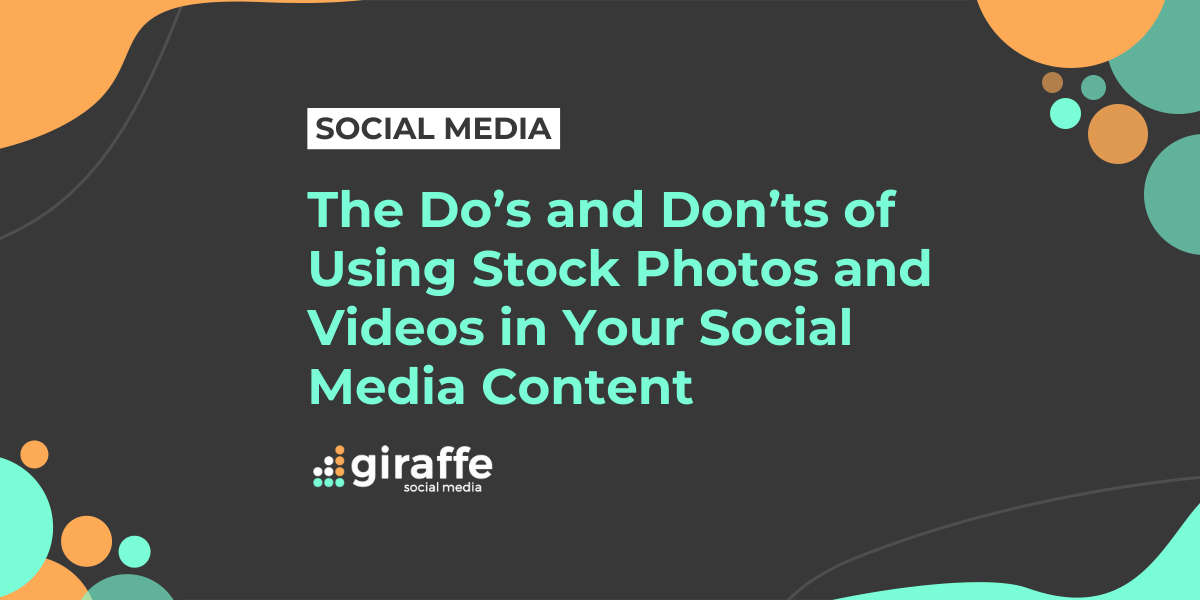Your social media marketing strategy likely involves a lot of visual content, no matter your industry. Photo and video-sharing app Instagram is one of the biggest social media platforms out there, with roughly 1 billion monthly active users. Facebook is also heavily visual, with a big focus on video content, so utilising visual content is key to get in front of the 2.23 billion monthly active Facebook users. Animated GIFs and videos perform well on LinkedIn and Twitter, grabbing the user’s attention and increasing your brand awareness.
Due to this big shift towards visual content, brands must be producing high-quality visual posts to keep their audience’s interest. But for many brands, especially small-to-medium-sized businesses, it’s not feasible or possible to create original photos and videos for every post. For this reason, stock photos, videos, and other assets are a core element of many brands’ social media presences.
What Are Stock Photos and Videos?
Stock photos and videos are made available by the photographer/creator for others to use, either free of charge, by crediting the creator, or through paying a licence fee to the creator and/or to a stock agency. Finding stock photography is easier than ever with the prominence of stock photo websites such as Pexels, Pixabay, and Unsplash hosting millions of high-quality stock images.
Other Stock Assets
Alongside stock photography and video, there are plenty of other types of stock media available for use in the same way: vector files, audio files, royalty-free music, graphic designs, motion graphics, and more. Adobe Stock, a subscription-based model included with Adobe Creative Cloud, is a comprehensive stock library with “stock photos, premium stock images, stock video footage, royalty-free templates for Adobe apps, vector art and illustrations, and stock music and audio.”
Why Use Stock Media as a Brand?
To succeed in social media marketing, your brand should be posting multiple times per week, and visual-focused platforms are key for getting your brand out there. Stock photos, videos, graphics, audio, and more can all help you consistently create brilliant social media content to a high standard. For companies with limited resources and less ability to capture their own photography/video for every single post, stock photos and videos make social media posting far easier.
To Do’s of Using Stock Photos and Videos
Check the Licence and Terms of Use
Licencing for stock assets can get quite confusing, so it’s important to double-check the licence and terms of use for any and every stock asset you consider using. There are three main categories that a stock licence will fall into: Rights Managed (RM); Royalty-Free (RF); and Extended Licences. All these licences will require at least one fee for use of the stock assets, so if you find images with these licences that you have not paid for, you’re unable to use them.
More commonly, there is the Creative Commons, a set of licences which “allow creators to give people permission to use their works” in some/certain circumstances. Creative Commons licences are often used on stock media websites, particularly those that require a subscription. Some photos found on these sites may specify that you need to give credit to the owner, but most are free to use without attribution providing you don’t resell the image as your own.
The bottom line is that you must always check the licence and terms of use before using stock photos, videos, and other media in your social media posts. Also, check what’s available to you; if you use Canva Pro or Adobe Creative Cloud (see Adobe Stock licence information here) to create your social media graphics, you have access to a stock photo and asset library through your current subscription.
Use Relevant Images
Stock photos and videos may be great for time-saving and getting posts out quickly, but make sure you’re using stock media that’s relevant to your post/brand. Images that are unrelated to or inappropriate for post/caption will harm your brand image and put your followers off. You need to make sure that there is an obvious link between the stock media you choose and the post it is for.
To Don’ts of Using Stock Photos and Videos
Copy & Paste Images from Search Engine Results
Some people assume that all images that come up in search engine results for “copyright-free images” are automatically all copyright-free and free to use – this is simply not the case. Never copy-and-paste straight from the image search results, as you will likely breach copyright. If you find an image you really like, click through to the link, and find the terms of use and licencing details there. You may find that it’s free to use, but often it’ll lead you to a paid-for stock site.
Use “Royalty-Free” Images Without Paying
As discussed above, licencing for stock media can get confusing. People tend to think “Royalty Free” means that use of the media is completely free, but this is not the case. Royalty-Free means that you don’t have to pay royalties for every single use of the media, but you do have to “pay a flat, predetermined rate” to be able to use it at all. If you find a stock photo labelled “Royalty-Free” that you have not paid for, you cannot use it in your social media posts.
Neglect Your Own Branding
Stock photos, videos, and other assets are great for filling out social media posts, but make sure you’re not neglecting your own branding and style when using them. Even simple things such as adding your logo or text in your brand font can go a long way in making your chosen photos look less ‘stock.’ This will mean that even if other brands use the same stock media as you, the audience can distinguish your brand through your use of colours, fonts, and logos.
Just make sure that you have permission to add your own elements and branding to put your own spin on the stock imagery. All stock websites will clearly lay out what you can and cannot do with the stock media that you want to use.






